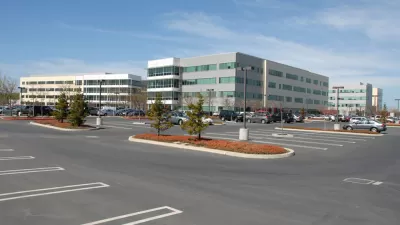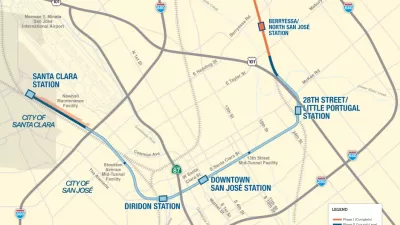A proposed BRT route between Palo Alto and San Jose is the latest to hit a setback.
"A proposal to create bus-only lanes on El Camino Real between Palo Alto and San Jose has hit a political speed bump," reports Gennady Sheyner, "with a committee of elected officials from all the Santa Clara County cities along the corridor coming out against the controversial reconfiguration and requesting an analysis of new alternatives."
The El Camino Rapid Transit Policy Advisory Board, comprised of city council members from three cities on the Peninsula in the Bay Area, meets with staff from the Santa Clara Valley Transportation Authority (VTA). The draft Environmental Impact Report has produced no shortage of controversy during the board's hearings. Of particular concern to critics of the EIR is plan alternative that would "transform the left lanes of El Camino into bus-only lanes," according to Sheyner. "This alternative, according to the draft environmental analysis, would shrink the time it takes to ride the bus from Palo Alto to San Jose from the current 85 minutes to 48 minutes."
At the end of October, the board sent VTA staff back to the drawing board, requesting two new alternatives for environmental analysis. The article goes into more detail about the politics surrounding the proposal and the most recent actions of the board.
Sheyner also notes that the difficult process for the El Camino BRT route mirrors another BRT project, further along in the process in San Jose. The route along Santa Clara Street, Alum Rock Avenue, Capitol Avenue and Capitol Expressway, "is now facing significant delays after construction was halted in July for a 'safety shutdown' relating to utilities, according to the VTA."
FULL STORY: Peninsula cities call for new Bus Rapid Transit options

Alabama: Trump Terminates Settlements for Black Communities Harmed By Raw Sewage
Trump deemed the landmark civil rights agreement “illegal DEI and environmental justice policy.”

Study: Maui’s Plan to Convert Vacation Rentals to Long-Term Housing Could Cause Nearly $1 Billion Economic Loss
The plan would reduce visitor accommodation by 25% resulting in 1,900 jobs lost.

Why Should We Subsidize Public Transportation?
Many public transit agencies face financial stress due to rising costs, declining fare revenue, and declining subsidies. Transit advocates must provide a strong business case for increasing public transit funding.

Paris Bike Boom Leads to Steep Drop in Air Pollution
The French city’s air quality has improved dramatically in the past 20 years, coinciding with a growth in cycling.

Why Housing Costs More to Build in California Than in Texas
Hard costs like labor and materials combined with ‘soft’ costs such as permitting make building in the San Francisco Bay Area almost three times as costly as in Texas cities.

San Diego County Sees a Rise in Urban Coyotes
San Diego County experiences a rise in urban coyotes, as sightings become prevalent throughout its urban neighbourhoods and surrounding areas.
Urban Design for Planners 1: Software Tools
This six-course series explores essential urban design concepts using open source software and equips planners with the tools they need to participate fully in the urban design process.
Planning for Universal Design
Learn the tools for implementing Universal Design in planning regulations.
Smith Gee Studio
Alamo Area Metropolitan Planning Organization
City of Santa Clarita
Institute for Housing and Urban Development Studies (IHS)
City of Grandview
Harvard GSD Executive Education
Toledo-Lucas County Plan Commissions
Salt Lake City
NYU Wagner Graduate School of Public Service





























